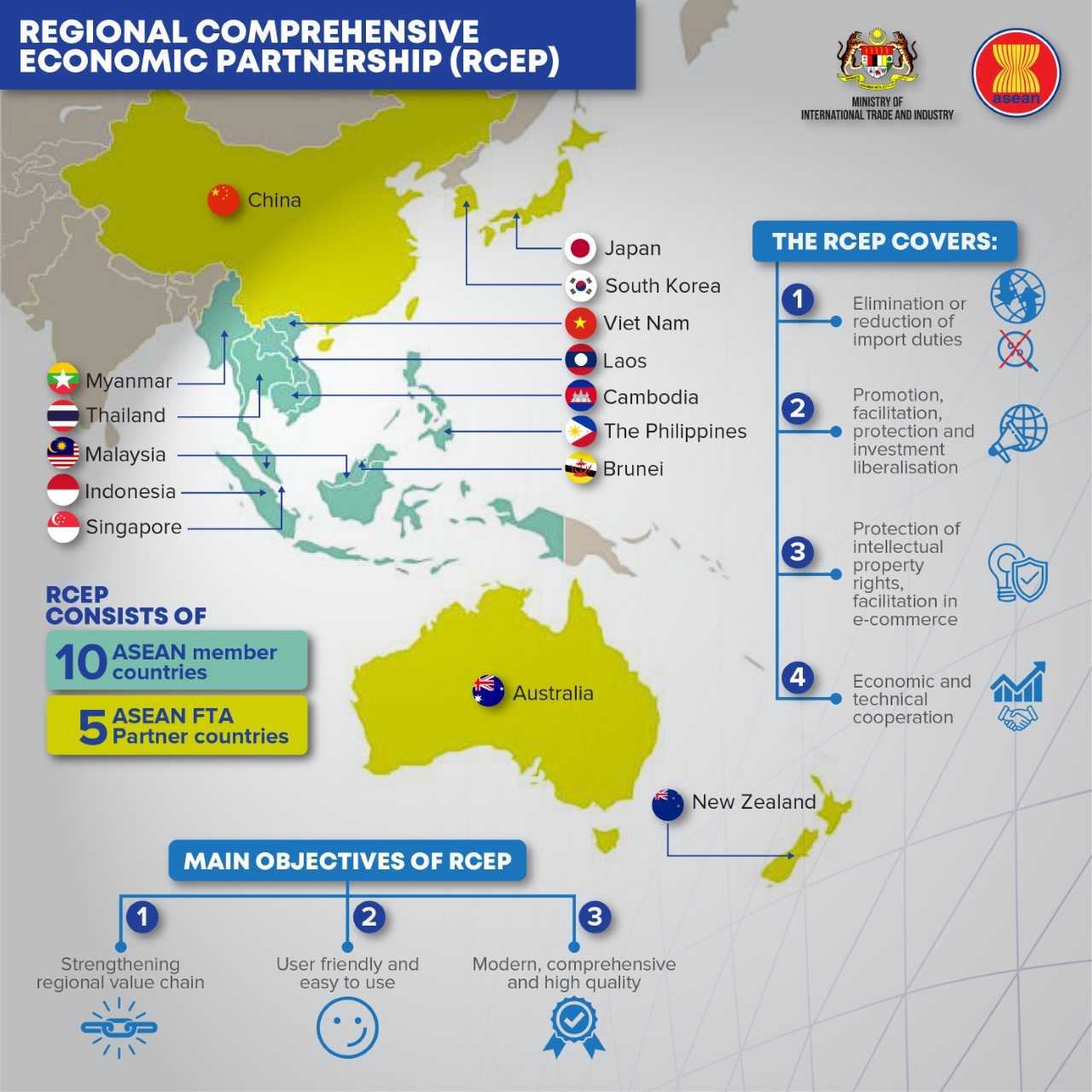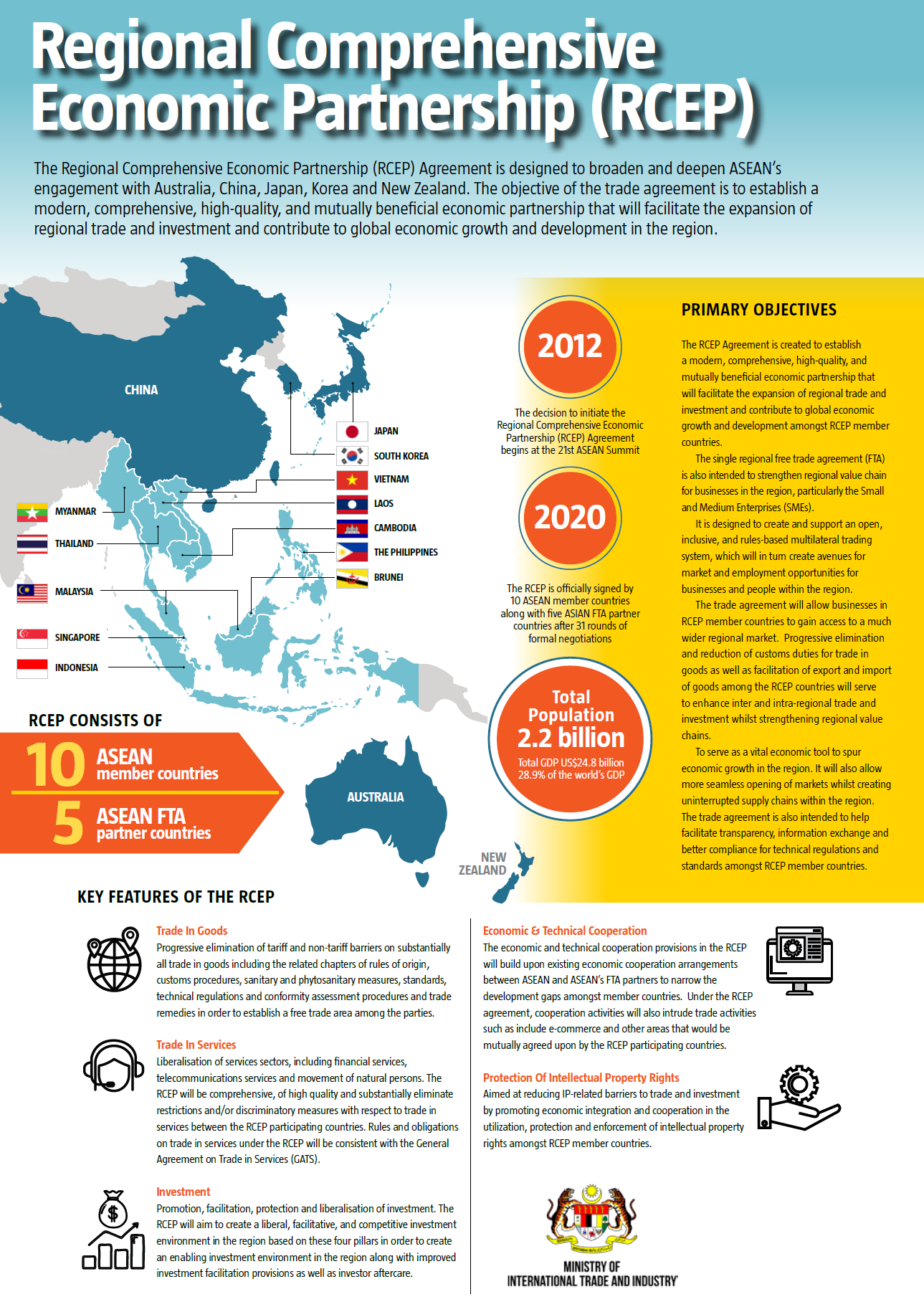- Infographic
- Background
- Scope
- Benefits to Malaysia
- Summary of the RCEP agreement
- Related Documents
- Contact Us
BACKGROUND
-
The RCEP negotiations was launched in November 2012 at the 21st ASEAN Summit in Phnom Penh, Cambodia but the negotiations only formally started in 2013.
-
Initially, RCEP was negotiated by 16 countries, consisting 10 ASEAN Member States (AMS) and ASEAN’s Free Trade Area (FTA) Partners or better known as AFPs. The AFPS are Australia, China, India, Japan, Korea as well as New Zealand.
-
Later in November 2019, during the ASEAN Summit, Prime Minister of India, Mr Narendra Modi announced that India cannot join RCEP in its current form.
-
In gist, the objective of RCEP is to streamline and amalgamate the ASEAN FTAs with its Dialogue Partners (ASEAN + 1 FTAs) into a single regional trade agreement that can contribute to strengthening regional value chain actives in the region as well make RCEP more user-friendly and simpler to use especially for the Small and Medium Enterprises (SMEs).
-
The ASEAN + 1 FTAs are:
-
ASEAN-China FTA
-
ASEAN-Australia New Zealand FTA
-
ASEAN-India FTA
-
ASEAN-Japan FTA
-
ASEAN-Korea FTA
-
-
When the RCEP Agreement is implemented, it will cover:
-
Tariff elimination and reduction for merchandise goods, including the facilitation of export and import of goods among the RCEP countries.
-
Opening markets to welcome the services providers within the RCEP region for sectors, including financial services, telecommunications services and movement of natural persons;
-
Promotion, facilitation and protection on investment within the region;
-
To ensure a level playing field to ASEAN countries while recognising the importance of special and differential treatment among RCEP countries especially the developing countries; and
-
information exchange and promotion of transparency measures to facilitate business and investment within the region including providing economic and technical cooperation especially to SMEs .
-
SCOPE
The scope of the RCEP negotiating areas is comprehensive and include the following:
-
Tariff elimination for trade in goods, including the related chapters of rules or origin, customs procedures, sanitary and phytosanitary measures, standards, technical regulations and conformity assessment procedures and trade remedies;
-
Liberalisation of services sectors, including financial services, telecommunications services and movement of natural persons;
-
Promotion, facilitation, protection and liberalisation of investment;
-
Competition policy (countries are allowed to implement national laws related to state-owned enterprises), intellectual property rights, electronic commerce and government procurement (no market access, only for information exchange and promotion of transparency measures),
-
Economic and technical cooperation and SMEs; and
-
Legal and institutional issues.
BENEFITS TO MALAYSIA
-
The major beneficiary of this mega FTA will be ASEAN. Based on World Bank data in 2020, the 15 RCEP Participating Countries (RPCs) account for:
-
A total of 29.46% of the global population or 2.3 billion people.
-
Combined Gross Domestic Products (GDP) of US$25.9 trillion (RM109.6 trillion) or 30.64% of the world's GDP.
-
Accounts for US$10.09 trillion (RM42.73 trillion) or 28.33% of global merchandise trade.
-
The five ASEAN FTA Partners (AFPs) are major investors in ASEAN contributing US$23.7 billion (RM100.37 billion) or 17.26% of the total Foreign Direct Investment (FDI) flow of US$137.3 billion (RM581.45 billion).
-
-
RCEP will benefit towards Malaysian companies by:
-
Offering market access to a third of world’s population where intra-regional sourcing of raw materials at competitive price,
-
Integrating supply chain within the RCEP region,
-
Promoting greater transparency, information sharing, trade facilitation, economic cooperation, standardisation of international rules relating to E-commerce,
-
Mutually recognising international standards, technical regulations trade, and
-
Providing clarity in protection of intellectual property rights.
-
SUMMARY OF THE RCEP AGREEMENT
RELATED DOCUMENTS
Legal Text of the RCEP Agreement
- Title page, Table of Contents, and Preamble
- Chapter 1 - Initial Provisions and General Definitions
- Chapter 2 - Trade in Goods
- Chapter 3 - Rules of Origin
- Chapter 4 - Customs Procedures and Trade Facilitation
- Chapter 5 - Sanitary and Phytosanitary Measures
- Chapter 6 - Standards, Technical Regulations, and Conformity Assessment Procedures
- Chapter 7 - Trade Remedies
- Chapter 8 -Trade in Services
- Chapter 9 - Temporary Movement of Natural Persons
- Chapter 10 - Investment
- Chapter 11 Intellectual Property
- Chapter 12 - Electronic Commerce
- Chapter 13 - Competition
- Annex 13A (Application of Article 13.3 (Appropriate Measures against Anti-Competitive Activities) and Article 13.4 (Cooperation) to Brunei Darussalam)
- Annex 13B (Application of Article 13.3 (Appropriate Measures against Anti-Competitive Activities) and Article 13.4 (Cooperation) to Cambodia)
- Annex 13C (Application of Article 13.3 (Appropriate Measures against Anti-Competitive Activities) and Article 13.4 (Cooperation) to Lao PDR)
- Annex 13D (Application of Article 13.3 (Appropriate Measures against Anti-Competitive Activities) and Article 13.4 (Cooperation) to Myanmar)
- Chapter 14 - Small and Medium Enterprises
- Chapter 15 - Economic and Technical Cooperation
- Chapter 16 - Government Procurement
- Chapter 17 - General Provisions and Exceptions
- Chapter 18 - Institutional Provisions
- Chapter 19 - Dispute Settlement
- Chapter 20 - Final Provisions
- Testimonium and Signing Pages
Market Access Annexes Annex I - Schedules of Tariff Commitments
- Annex I - General Headnotes
- Brunei Darussalam - Headnotes
- Brunei Darussalam - Schedule of Tariff Commitments
- Cambodia- Headnotes
- Cambodia - Schedule of Tariff Commitments
- Indonesia - Headnotes
- Indonesia - Schedule of Tariff Commitments
- Indonesia - Schedule of Tariff Commitments for ASEAN
- Indonesia - Schedule of Tariff Commitments for Australia
- Indonesia - Schedule of Tariff Commitments for China
- Indonesia - Schedule of Tariff Commitments for Japan
- Indonesia - Schedule of Tariff Commitments for Korea
- Indonesia - Schedule of Tariff Commitments for New Zealand
- Indonesia - Appendix on Tariff Differentials
- Lao PDR - Headnotes
- Lao PDR - Schedule of Tariff Commitments
- Malaysia - Headnotes
- Malaysia - Schedule of Tariff Commitments
- Myanmar - Headnotes
- Myanmar - Schedule of Tariff Commitments
- Philippines - Headnotes
- Philippines - Schedule of Tariff Commitments
- Philippines - Schedule of Tariff Commitments (Common Concession)
- Philippines - Schedule of Tariff Commitments for Australia and New Zealand
- Philippines - Schedule of Tariff Commitments for China
- Philippines - Schedule of Tariff Commitments for Japan
- Philippines - Schedule of Tariff Commitments for Korea
- Philippines - Appendix on Tariff Differentials
- Singapore - Headnotes
- Thailand - Headnotes
- Thailand - Schedule of Tariff Commitments
- Thailand - Appendix on Tariff Differentials
- Viet Nam - Headnotes
- Viet Nam - Schedule of Tariff Commitments
- Viet Nam - Schedule of Tariff Commitments for ASEAN
- Viet Nam - Schedule of Tariff Commitments for Australia
- Viet Nam - Schedule of Tariff Commitments for China
- Viet Nam - Schedule of Tariff Commitments for Japan
- Viet Nam - Schedule of Tariff Commitments for Korea
- Viet Nam - Schedule of Tariff Commitments for New Zealand
- Viet Nam - Appendix on Tariff Differentials
- Australia - Headnotes
- Australia - Schedule of Tariff Commitments
- China - Headnotes
- China - Schedule of Tariff Commitments
- China - Appendix on Tariff Differentials
- Japan - Headnotes
- Japan - Schedule of Tariff Commitments
- Japan - Appendix on Tariff Differentials
- Korea - Headnotes
- Korea - Schedule of Tariff Commitments
- Korea - Appendix on Tariff Differentials
- New Zealand - Headnotes
- New Zealand - Schedule of Tariff Commitments
Annex II – Schedules of Specific Commitments for Services
- Cambodia - Schedule of Specific Commitments for Services
- Lao PDR - Schedule of Specific Commitments for Services
- Myanmar - Schedule of Specific Commitments for Services
- Philippines - Schedule of Specific Commitments for Services
- Thailand - Schedule of Specific Commitments for Services
- Viet Nam - Schedule of Specific Commitments for Services
- China - Schedule of Specific Commitments for Services
- New Zealand - Schedule of Specific Commitments for Services
Annex III – Schedules of Reservations and Non-Conforming Measures for Services and Investment
- Brunei Darussalam - Schedule of Reservations and Non-Conforming Measures for Services and Investment
- Cambodia - Schedule of Reservations and Non-Conforming Measures for Investment
- Indonesia - Schedule of Reservations and Non-Conforming Measures for Services
- Indonesia - Schedule of Reservations and Non-Conforming Measures for Investment
- Lao PDR - Schedule of Reservations and Non-Conforming Measures for Investment
- Malaysia - Schedule of Reservations and Non-Conforming Measures for Services and Investment
- Myanmar - Schedule of Reservations and Non-Conforming Measures for Investment
- Philippines - Schedule of Reservations and Non-Conforming Measures for Investment
- Singapore - Schedule of Reservations and Non-Conforming Measures for Services and Investment
- Thailand - Schedule of Reservations and Non-Conforming Measures for Investment
- Viet Nam - Schedule of Reservations and Non-Conforming Measures for Investment
- Australia - Schedule of Reservations and Non-Conforming Measures for Services and Investment
- China - Schedule of Reservations and Non-Conforming Measures for Investment
- Japan - Schedule of Reservations and Non-Conforming Measures for Services and Investment
- Korea - Schedule of Reservations and Non-Conforming Measures for Services and Investment
- New Zealand - Schedule of Reservations and Non-Conforming Measures for Investment
Annex IV – Schedules of Specific Commitments on Temporary Movement of Natural Persons
- Brunei Darussalam – Schedule of Specific Commitments on Temporary Movement of Natural Persons
- Cambodia – Schedule of Specific Commitments on Temporary Movement of Natural Persons
- Indonesia – Schedule of Specific Commitments on Temporary Movement of Natural Persons
- Lao PDR– Schedule of Specific Commitments on Temporary Movement of Natural Persons
- Malaysia – Schedule of Specific Commitments on Temporary Movement of Natural Persons
- Myanmar – Schedule of Specific Commitments on Temporary Movement of Natural Persons
- Philippines – Schedule of Specific Commitments on Temporary Movement of Natural Persons
- Singapore – Schedule of Specific Commitments on Temporary Movement of Natural Persons
- Thailand – Schedule of Specific Commitments on Temporary Movement of Natural Persons
- Viet Nam – Schedule of Specific Commitments on Temporary Movement of Natural Persons
- Australia – Schedule of Specific Commitments on Temporary Movement of Natural Persons
- China – Schedule of Specific Commitments on Temporary Movement of Natural Persons
- Japan – Schedule of Specific Commitments on Temporary Movement of Natural Persons
- Korea – Schedule of Specific Commitments on Temporary Movement of Natural Persons
- New Zealand – Schedule of Specific Commitments on Temporary Movement of Natural Persons
CONTACT US
For matters relating to the processing of Preferential Certificate of Origin (CO Form RCEP) / Rules of Origin, please contact:
- Ms. Izzati Saadiah Mohamad Saad
DL: 03-62084803
Email: izzatisaadiah@miti.gov.my
- Ms. Nurazira Amira Saiful Bahri
DL: 03-62084735
Email: n.amira@miti.gov.my
- Ms. Nurul Afifah Fauzi
DL: 03-62084801
Email: afifah.mystep@miti.gov.my
- Mr. Muhammad Faris Sameon
DL: 03-62084750
Email: faris@miti.gov.my
- Ms. Siti Hawani Hamidun
DL: 03-62084724
Email: hawani@miti.gov.my
- Ms. Emilda Zulkeflee
DL: 03-62084721
Email: emilda@miti.gov.my
- Ms. Sumathi Visualingom
DL: 03-62084717
Email: sumathi.lingom@miti.gov.my
Further information related to Cost Analysis (CA) and Preferential Certificate of Origin (PCO) on RCEP, kindly send an email to:
or drop by at The Business Advisory Centre, Level 2, MITI Tower, Jalan Sultan Haji Ahmad Shah (Jln. Duta), Kuala Lumpur. Consultation hours:
- Monday – Thursday: 10:30am – 12:30pm / 2:30pm – 4:30pm
- Friday: 10:30am – 12:00 noon / 3:00pm – 4:30pm
|
Ministry of Investment, Trade and Industry
Visitor Count : 1366709
Last updated : 01-07-2025
|
Security Policy | Privacy Policy | Term & Conditions | Disclaimer
Best viewed using Internet Explorer 10 and above with resolution 1280 x 800 |
 |
| 













